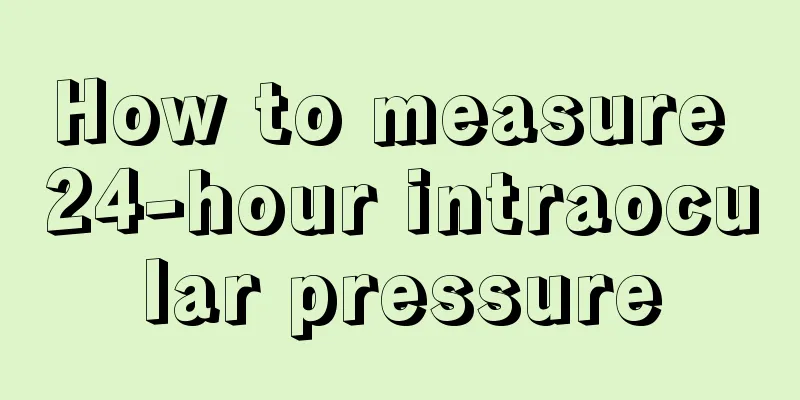How to measure 24-hour intraocular pressure

|
Each of us hopes to be healthy, but we always avoid it in our daily life. It is said that the eyes are the windows to the soul. We deal with various bacteria every day, and if we are not careful, we will bring bacteria into our eyes, so various eye diseases will come. Once you find that you have an eye disease, you must measure the intraocular pressure in time, especially the 24-hour intraocular pressure. So how do you measure the 24-hour intraocular pressure? During hospitalization, intraocular pressure is monitored for 24 hours. Nursing needs to understand the following points in order to obtain accurate values, achieve the purpose of early diagnosis and early treatment of glaucoma, and observe the effectiveness of glaucoma treatment. 1. Things to know before monitoring: 1. The seven periods of time for monitoring intraocular pressure are: The seven periods of time for monitoring intraocular pressure are: 10:00 14:00 18:00 22:00 01:00 05:00 07:00 2. Diet and drinking: Eat a light diet, avoid coffee and strong tea, avoid smoking and drinking, and drink no more than 300 ml of water at a time. You can drink small amounts of water multiple times to keep your bowels open. 3. Light: Do not stay in a dark place for a long time. Keep the room well lit. You can turn on the desk lamp at night and do not wear sunglasses. 4. Lying position: Maintain a comfortable position and avoid prone position. The pillow should not be too low. 5. Life and exercise: You can engage in normal activities, but avoid strenuous exercise. Avoid excessive fatigue, ensure adequate sleep, avoid bending over for long periods of time, and collars and belts should not be too tight. 6. Eye hygiene: The time spent reading books, newspapers, mobile phones and other electronic products should not be too long, no more than 30 minutes. 7. Psychologically: Keep your emotions stable, don’t be anxious, and don’t lose your temper. 8. Use intraocular pressure-lowering drugs as prescribed by your doctor. 2. Note when measuring: 1. Urinate before measurement, do not hold it. 2. If there are tears in your eyes, wipe them away immediately. 3. If you do strenuous exercise, please rest for ten minutes before measuring. 4. Adjust your head as required by the nurse. Do not move your head. Look straight ahead naturally. Look at the green light in the lens with the eye being tested. Keep your eyes in this position, relax, and breathe normally. Do not blink hard or hold your breath. Measure 3 times in natural mode. 5. During the measurement, airflow will impact your eyes, but it will not cause any harm, so do not avoid it. 3. Notes after monitoring: 1. If you experience eye pain, headache, or sudden decrease in vision, inform medical staff immediately. 2. Communicate with your doctor to determine the treatment plan. Patients who need medication should learn how to use intraocular pressure-lowering drugs. 3. Check regularly and, if necessary, check the visual field, OCT and other related examinations every 3 to 6 months. |
<<: Why does it hurt so much after taking penicillin
>>: Symptoms and hazards of high intraocular pressure
Recommend
Methods for treating early childhood lung cancer
The treatment of cancer has always been a concern...
How to treat bone metastasis of nasopharyngeal carcinoma
How should bone metastasis of nasopharyngeal carc...
How to cut mango into pieces
In daily life, many people like to eat mangoes ve...
What kind of tea to make for gynecological inflammation
Many plants can be used to make tea. Common ingre...
What are the causes of pulpitis?
It is important to understand the cause of pulpit...
Find out 5 commonly ignored allergens in the home
When it comes to allergy prevention, many people ...
What medicine is good for tongue cancer in middle-aged people
What medicine is good for middle-aged people with...
What are the symptoms of non-atrophic gastritis?
Non-atrophic gastritis seriously affects the heal...
6 little things that keep you losing hair
In autumn, hair loss is showing a trend of "...
What are the nursing measures for lymphoma that need to be kept in mind
The treatment of lymphoma is still mainly based o...
Eating eggplant makes my stomach uncomfortable
When food is eaten, the first organ that comes in...
The efficacy and function of sandalwood mosquito coils
Now the weather is getting hotter and hotter, man...
What causes stomach pain after eating?
Many friends will experience stomach pain after e...
What does root nodule mean
Although the word "tumor" is included i...
What food to eat for early laryngeal cancer
Laryngeal cancer is a very serious malignant tumo...









